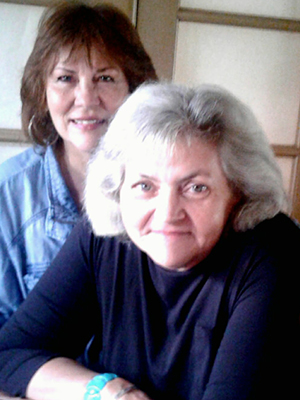Hiding in Plain Sight
By Pam Auchmutey

Sharron Close co-directs a clinic for children with X and Y variations at Emory. The clinic will be included in a documentary to help raise awareneness about these disorders.
Sometimes, baby sisters can be a handful. When Carole Steinkraus recently broke her leg, it proved to be more than a physical setback. She also experienced serious post-surgery reactions similar to post-traumatic stress disorder.
"I don't know what's happened to me," Carole told her big sister and documentary filmmaker Dianne Steinkraus. "I was doing so well. Now it's like I don't know who I am. Why did I have to break my leg?"
Carole, 60, is now in assisted living in Minnesota, where she has lived in various foster group homes since her 20s.
|
Carole Steinkraus (right) is the inspiration behind the documentary that her sister, Dianne Steinkraus, is making. Carole was diagnosed with trisomy X at age 53. |
For years, Dianne consulted with doctors and behavioral experts to learn the cause of her sister's complex mental health issues. Finally, when Carole was 53, genetic testing confirmed that she had trisomy X, a sex chromosome abnormality that affects 1 in 1,000 females at birth.
The sisters finally had an explanation for Carole's lifelong struggles with anxiety, insecurity, and difficulty connecting with family members and friends. It also explained why she was 6 feet tall by age 12.
But even with the trisomy diagnosis, Carole's doctors knew little about her disorder and had little more to offer regarding her mental health treatment plan. Dianne reached out to the national advocacy group AXYS (Association for X & Y Variations) to learn more about research on trisomy X. By then, her sister's story had revealed a clear need for a documentary to shed light on sex chromosome disorders.
"Why don't you call Sharron Close," a leader with AXYS told her.
Dianne found a kindred spirit in Close PhD MS FAAN, a pediatric nurse practitioner at Emory's School of Nursing who studies children and adults with X and Y variations. "I understand your frustration," Close told her when they first spoke over the phone.
The two have become friends and collaborators on Steinkraus's documentary film project to raise awareness about X and Y variations. Last spring, the School of Nursing and Steinkraus conducted a crowd-funding campaign that raised nearly $26,000 toward production of "Hiding in Plain Sight," the working title of the film. The funds will support creation of a 10-minute segment to help Steinkraus secure additional funding to complete the documentary.
Among the projects to be featured in the film is the eXtraordinarY Clinic at Emory. Close and Amy Talboy MD, a developmental pediatrician in the Department of Human Genetics, established the clinic in 2016 to serve patients and families in the Southeast. It is one of a network of eXtraordinarY Kids Clinics in the United States that provides information, research, and medical interventions.
X and Y conditions are not inherited and occur when girls (XX) and boys (XY) are randomly born with more or less than the expected number of sex chromosomes. Some people with variations live free of or are mildly affected by symptoms, while others face lifelong medical and mental health challenges. X and Y variations are not rare. But they are rarely diagnosed, leaving children, adults, and families to struggle on their own.
"Families have been falling through the cracks for decades," says Close. "Our clinic meets a tremendous need."
Once a month, the eXtraordinarY Clinic sees two to three babies and children who have been diagnosed via chromosomal analysis. Clinicians evaluate their needs and connect children and parents with early intervention programs, speech and language therapies, and occupational and physical therapies as needed.
When children reach puberty, clinicians can address reproductive health problems that may arise. They can also counsel expectant parents concerned about possible risk of X and Y variations detected through prenatal screening.
A genetic counselor, nurse navigator, neuropsychologist, pediatric endocrinologist, and adult urologist staff the clinic in addition to Close and Talboy.
"We tailor our recommendations, depending on the age and needs of each patient," says Close. "We tell families we will follow you, we will help you, we will be a touchpoint and a resource for you."
Until recently, most X and Y research offered few interventions to help patients and families coping with a challenging behavioral and physical condition. To close that gap, Close organized conferences in 2015 and 2016 to engage patients, families, clinicians, and scientists in developing ways to help children and parents manage X and Y symptoms. The No. 1 goal of patients and families in attendance, she found, was to raise awareness and promote education about sex chromosome variations.
For the past two years, Georgia Governor Nathan Deal has signed a proclamation declaring May as X & Y Chromosome Variation Awareness Month, marking a milestone in a grassroots campaign led by Close, Talboy, and Dorothy Boothe, whose son has XXY (Klinefelter) syndrome, which occurs in one out of 500 male births.
Boothe is a parent leader with the Southeastern Regional X and Y Support Group, which meets bimonthly, often at the School of Nursing. She and other support group members were at the Georgia State Capitol when Deal read the proclamation for which they had lobbied.
"It was so important for families to be there with the governor and state legislators to talk about who they are and what they need," says Close. "It was powerful. We're all very proud of that."
Falling Through the Cracks
Why have so few children and adults been diagnosed with sex chromosome disorders?
It wasn't until 1959 that the first genetic test showed that children with Down syndrome, or trisomy 21, had an extra full or partial copy of chromosome 21.
"Generally, there was no way of testing or characterizing X and Y chromosome variations," says Sharron Close, assistant professor in the School of Nursing. "Children born with these disorders were thought of as slow learners. Schools and education programs marginalized them. So people can struggle all of their lives with these disorders and not know why."
Carole Steinkraus, 60, was diagnosed with trisomy X late in life. Her formative and primary adult years were spent without anyone knowing that she had special needs. She is now part of Close's national study on trisomy X.
"There probably are many other women like Carole," says Close. "The truth is they most likely have escaped being diagnosed during their lifetime."
Related Links
"eXtraordinarY: New clinic for X and Y chromosome variations" (Nov. 15, 2017)


